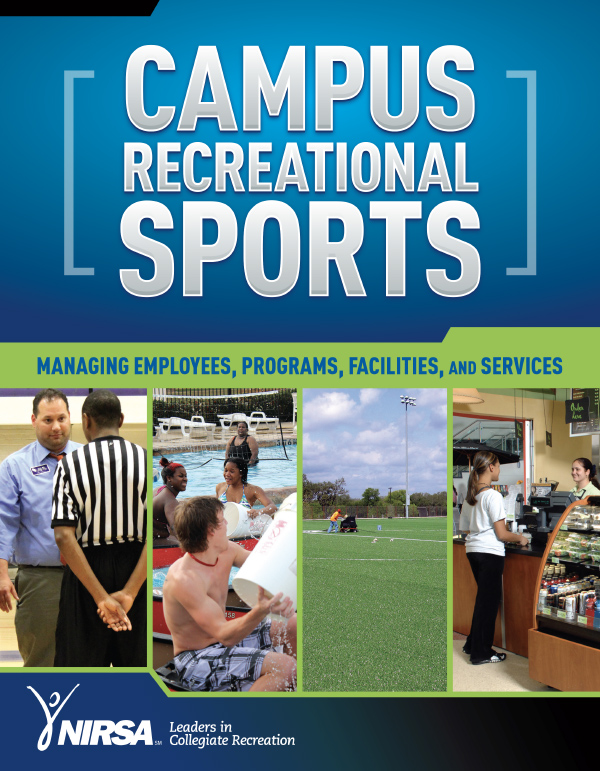Developed by the NIRSA, Campus Recreational Sports offers the latest industry guidelines and best practices based on the knowledge, expertise, and experience of leading campus recreation professionals across the nation.
Both current and future professionals can rely on Campus Recreational Sports for guidance in the management of indoor and outdoor recreation and sport facilities.
Management of campus recreational sport facilities has expanded in both scope and complexity in the 21st century. Today’s state-of-the-art recreation and sport facilities offer high-end amenities for students, faculty, staff, and the surrounding community. Managing these diverse and complicated programs and facilities requires knowledge of operations, client services, and industry standards. Campus Recreational Sports: Managing Employees, Programs, Facilities, and Services addresses the unique skill set and knowledge base required of today’s campus recreation and sport facility manager. This reference offers current and aspiring professionals a comprehensive and practical discussion of campus recreation management. Chapters covering foundational topics of budgeting, marketing, assessment, risk management, and management of personnel, facilities, and services are complemented by current topics in technology, programming, and community building.
Table of Contents
Preface
Acknowledgments
Chapter 1. Evolution of Campus Recreational Sports: Adapting to the Age of Accountability
Doug Franklin
Defining Campus Recreational Sports in a Changing World
Learning and the Age of Accountability
Evolution in Campus Recreational Sports: Adaptation in a Changing World
Organizational Fit and Location
Issues and Trends
Summary
References
Glossary
Chapter 2. A Career in Campus Recreational Sports
Sarah E. Hardin
Growth of the Profession
Campus Recreational Sports as a Career
Professional Preparation
Educational Credentials
Opportunities to Attain Professional Skills
Lifelong Learning: Professional Development Opportunities
Principles of the Profession
Summary
References
Glossary
Chapter 3. Relationships in Campus Recreation: Professional, Institutional, and Community
Doug Franklin
Interpersonal Relationships
Intradepartmental Relationships
Interdepartmental and Intra-Institutional Relationships
Community Relationships
Professional Relationships
Summary
References
Glossary
Chapter 4. Budgeting and Internal Controls
Maureen McGonagle
What Is a Budget?
Budget Development
Budget Submission and Approval
Budget Management
Internal Controls
Summary
Glossary
Chapter 5. Marketing
Evelyn Kwan Green, Aaron Hill, and Bradley Hunt
Program Promotion
Marketing Plan
Sponsorship Solicitation
E-Marketing
Branding
Summary
Resources
References
Glossary
Chapter 6. Assessment in Campus Recreational Sports
Jacqueline R. Hamilton
Defining Terms
History of Assessment
Contemporary Issues in Assessment
Standards of Comparison
Types and Areas of Assessment
Methodology and Research Design
Dissemination of Information
Justification
Assessment Resources
Summary
References
Glossary
Chapter 7. Risk Management
Jeff Sessine
Principles of Risk Management
Managing Risk
Training
Response
Environment
Equipment
Documentation
Summary
References
Glossary
Chapter 8. Technology for the Recreation Practitioner
Robert L. Frye and José H. Gonzalez
Making the Right Selection
New Technology in Facility Management
New Technology in Sports and Fitness Equipment
Using Marketing Technology
Using Technology in Staff Development
Summary, Glossary, References
Chapter 9. Personnel
Stephen Kampf
Types of Recreation Employees
Hiring
Employee Training
Evaluation
Motivation
Certification
Summary, Glossary, References
Chapter 10. Program Planning Using a Student Learning Approach
Julia Wallace Carr
Step 1: Determine Priorities
Step 2: Develop Outcomes
Step 3: Develop Initiatives and Interventions
Step 4: Develop Measureable Outcomes
Step 5: Conduct Initiatives and Interventions
Steps 6 and 7: Conduct Assessment and Evaluation and Then Revise, Maintain, or Terminate
Summary, Glossary, References
Chapter 11. Facilities
Gordon M. Nesbitt
Facility Types
Standards and Guidelines
Scheduling
Staffing
Maintenance
Summary
References
Glossary
Chapter 12. Services
William F. Canning and Jennifer R. de-Vries
Membership
Equipment Checkout and Rentals
Child Care and Babysitting
Food Service
Athletic Training
Massage
Summary
Glossary
Chapter 13. Special Events
Gordon M. Nesbitt
Feasibility Study
Financial Planning
Staffing Plans
Rules and Officials Plans
Risk, Emergency, and Crisis Plans
Registration Plans
Scheduling Facilities
Equipment, Uniforms, and Supplies
Awards
Food Service Plans
Transportation Plans
Housing Plans
Promotion Plans
Communication Plans
Event Evaluation Plan
Summary
References
Glossary
Index
About NIRSA
About the Contributors
For questions regarding this publication, please contact NIRSA Senior Director of Operations Mary Callender.


